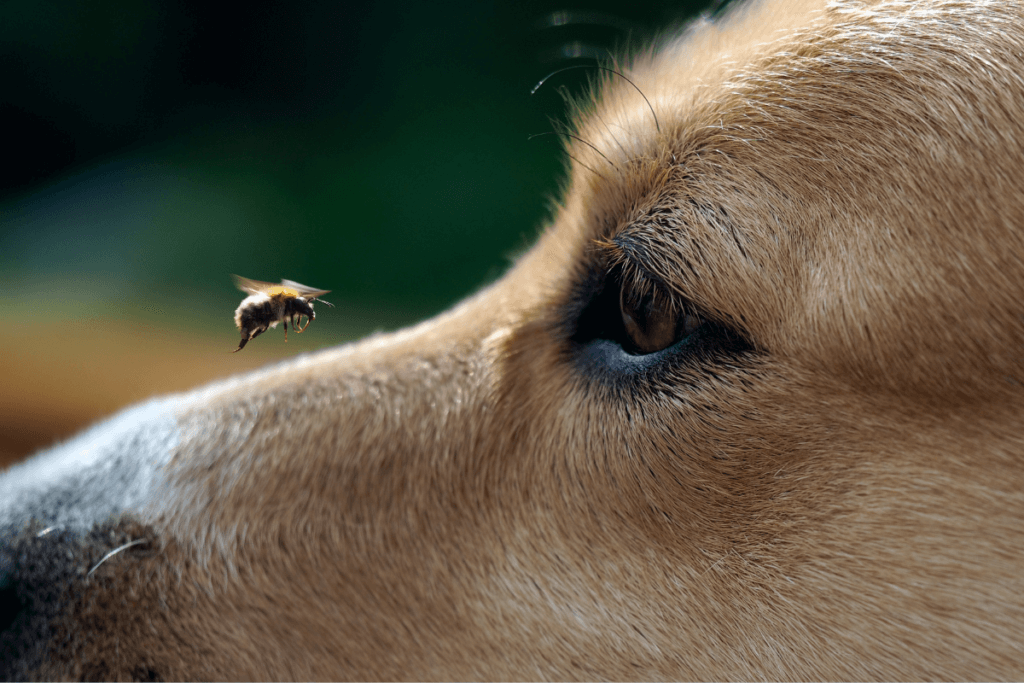The blooms of spring and summer are always welcome, and along with them come important pollinators like bees and wasps. With their noses to the ground and curious natures, it is not surprising that dogs suffer from wasp and bee stings more often than humans. In fact, just like for humans, there can be a range of responses to a bee sting from mild discomfort and swelling to life threatening anaphylaxis that requires emergency medical attention.
Table of contents:
What to know about bee stings
The most common sites for bee stings are on a dog’s muzzle or foot pad. If your dog has been running or nosing around in the grass and suddenly let out a pained yelp or come up limping off of one foot, you can suspect a wasp or bee sting. While less common, they might also eat a bee out of curiosity or they might eat something that has a bee or bees in it, such as an apple.
A single sting will be painful and probably lead to swelling, itching, or other discomfort, but it can be treated at home and should not cause pain that lasts for more than a little while.
When honeybees sting, they leave their stinger in the skin along with an attached venom sac that will continue to send in venom as long as the stinger is in place. It is important to remove the stinger as soon as possible to prevent the painful venom from continuing to enter the skin. Honeybees only sting once and die after they lose their stinger, but wasps and hornets do not lose their stingers and can sting multiple times.
Africanized ‘killer’ honeybees are hybrid bees that were developed in the 1950s to increase honey production in Brazil. They escaped quarantine and made their way to the US not long afterwards. Today, they are found across the southwestern United States and Florida. Africanized bees are more aggressive than other honeybees, and they attack in swarms. Their actual venom is similar to a honeybee’s but the number of stings (hundreds or even thousands) when attacked by a swarm can cause severe and life-threatening reactions.
What to do
Your dog might be scared and hurt from the sting, so keep their safety in mind as they might run or hide.
- If you can see the stinger, use a credit card or tweezers to carefully scrape the stinger free.
- A baking soda and water paste on the site of the sting will help neutralize the acidity of the sting and lessen the inflammation.
- Apply ice to the site of the sting to help with pain and swelling.
- Keep an eye on your dog for any swelling that can interfere with breathing. Most allergic reactions occur within 20 minutes of being stung, but you should continue to observe your dog for the next 24 hours to be sure.
When to seek help
If your dog has a history of severe reactions to bee stings, they should be seen by a vet any time a sting is suspected.
Swelling is normal at the site of a bee sting, but swelling that gets worse or persists for more than a few hours could be a sign of a more severe reaction.
If your dog has disturbed a hive and has multiple bee stings, or if they have immediate dramatic swelling, contact your veterinarian immediately or take them to an emergency vet. When people go into shock it affects their lungs and they have difficulty breathing. The gastrointestinal tract is impacted when dogs go into shock, a potentially life-threatening situation. Vomiting, collapse or general weakness, diarrhea, and difficulty breathing are all reasons to seek emergency veterinarian help as they might be signs of anaphylactic shock. Pale gums can be a sign that your dog is in shock and should immediately be seen.
In the case of suspected anaphylaxis, the veterinarian will evaluate your dog, and treatment can include IV fluids, pain medication, epinephrine, oxygen, and close monitoring. They might remain at the veterinary hospital for 2-3 days to ensure that their system has fully recovered.
Only give your dog Benadryl or another antihistamine if it is specifically recommended by your veterinarian.
In conclusion
Our dogs love being in nature, and unfortunately that can put them in close contact with a bee or wasp. For most dogs, this will be nothing more than a painful encounter and some swelling that can be managed at home with ice and fluids. It is important, however, to monitor your dog for signs of a more severe response to the sting, especially if they have any of the signs of anaphylaxis, and then seek immediate veterinary help.
Sources:
https://www.akc.org/expert-advice/health/dog-stung-bee-wasp/
https://www.whole-dog-journal.com/health/dog-stung-by-a-bee-heres-how-to-treat-it/
https://www.petmd.com/dog/conditions/respiratory/c_multi_anaphylaxis









